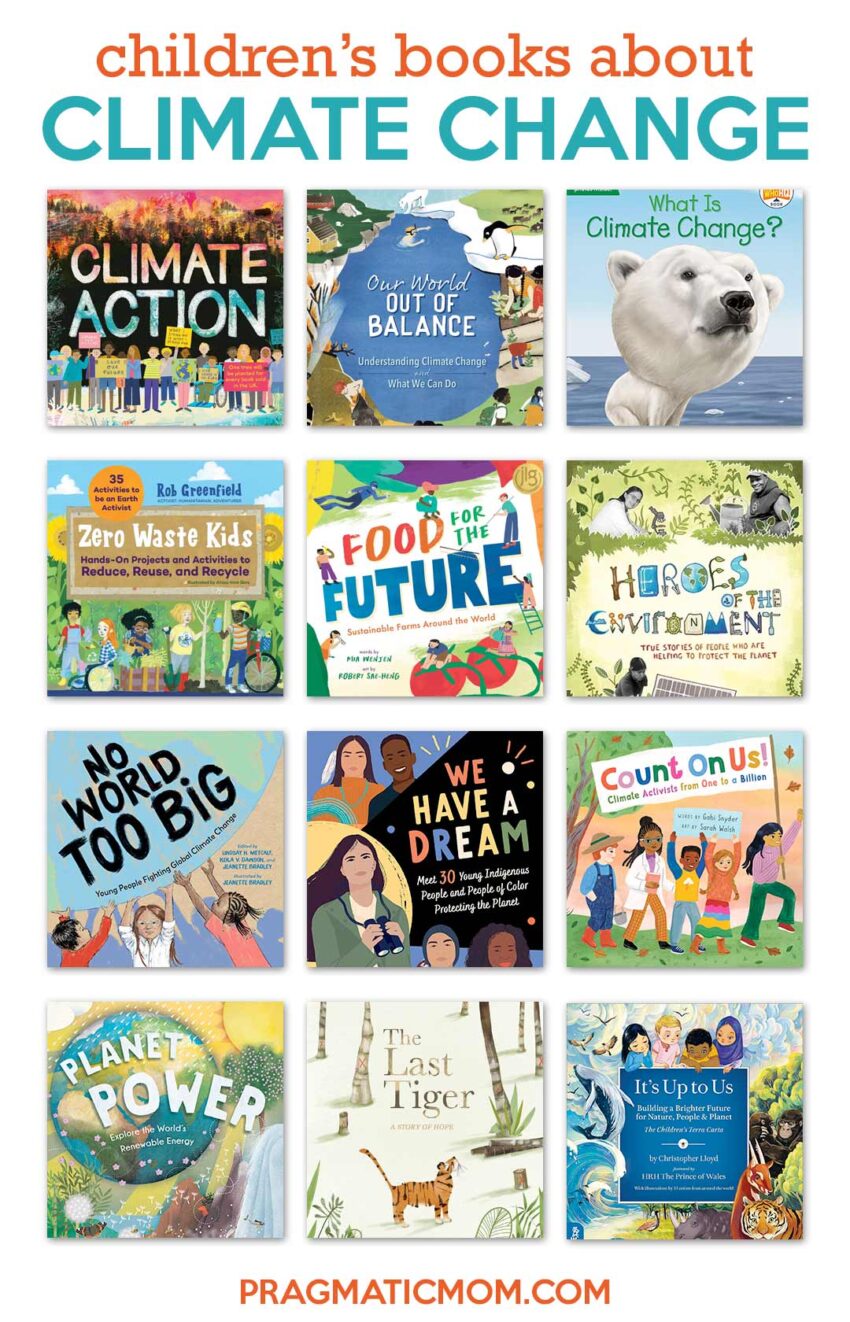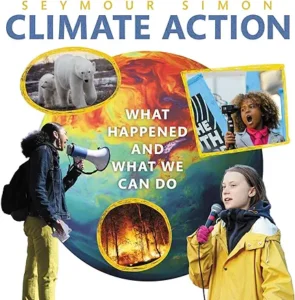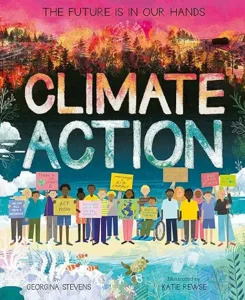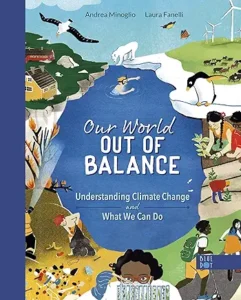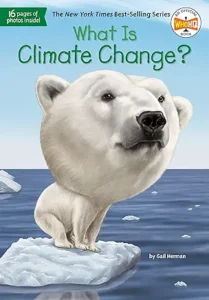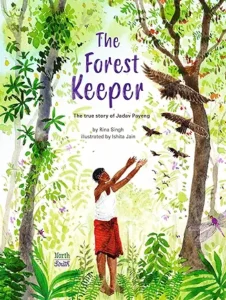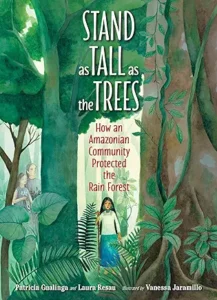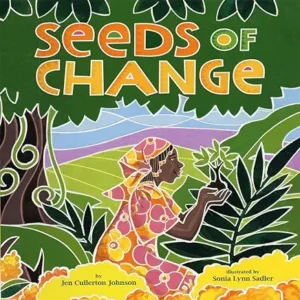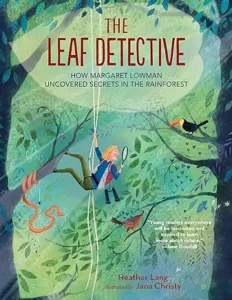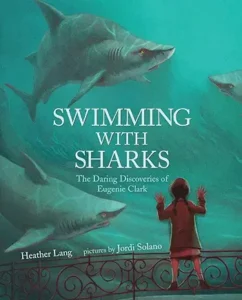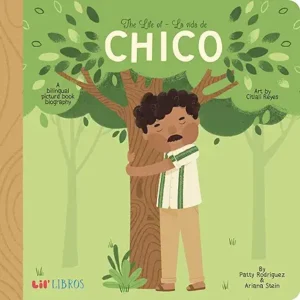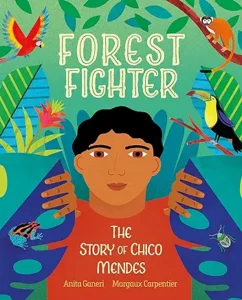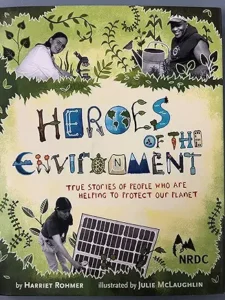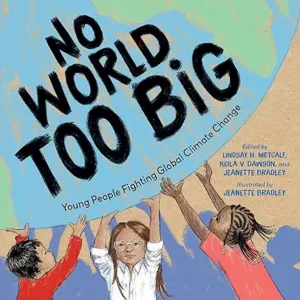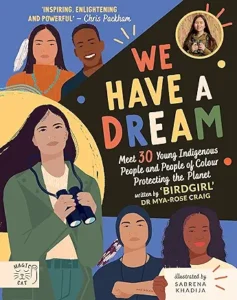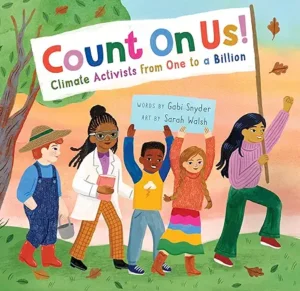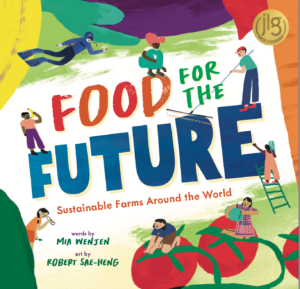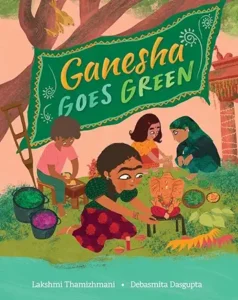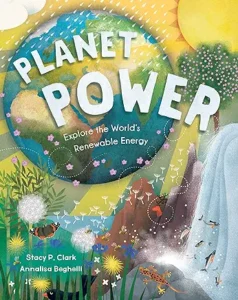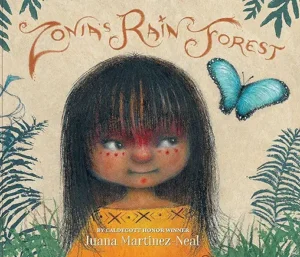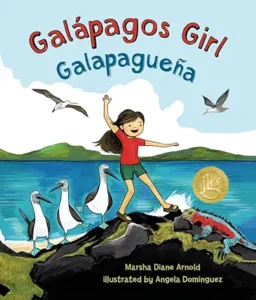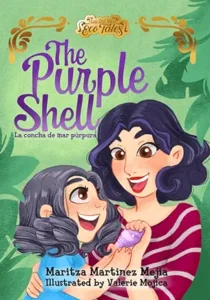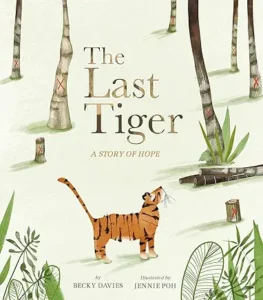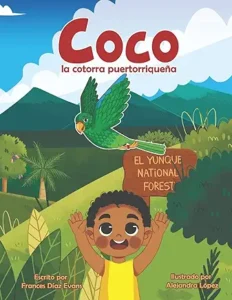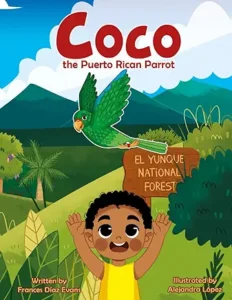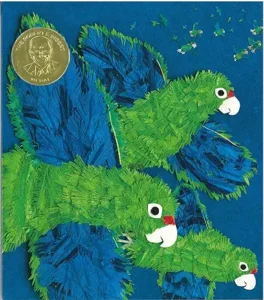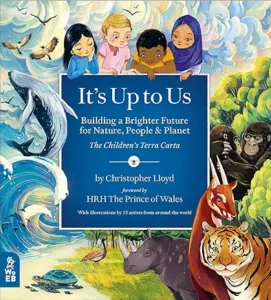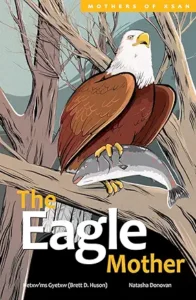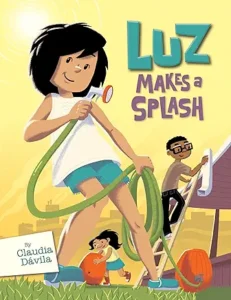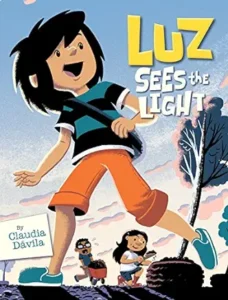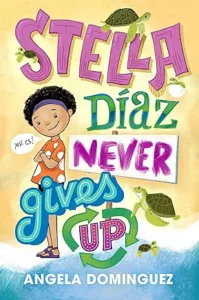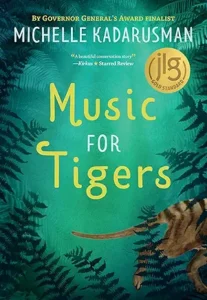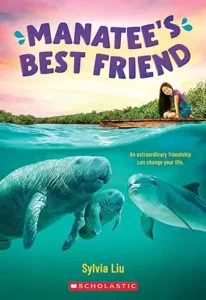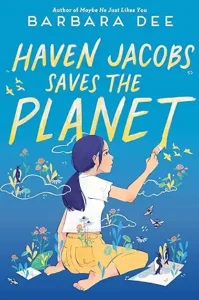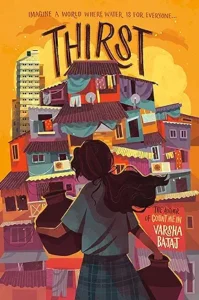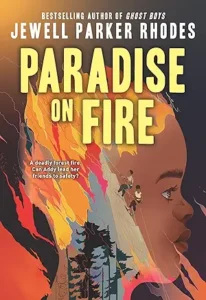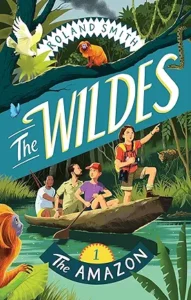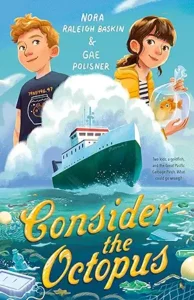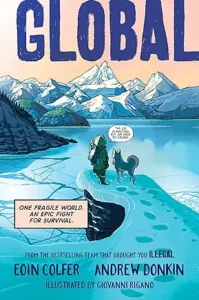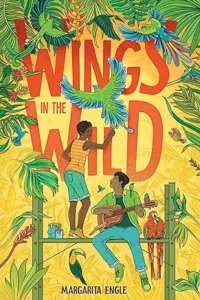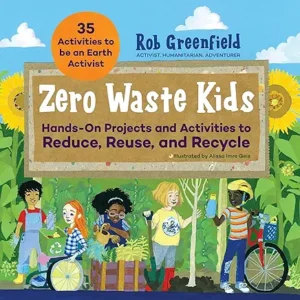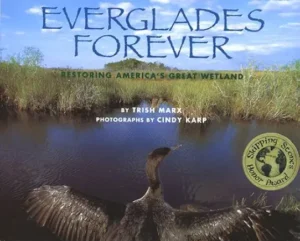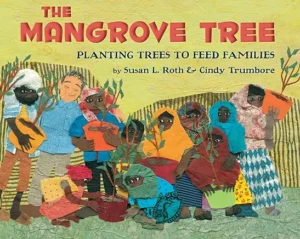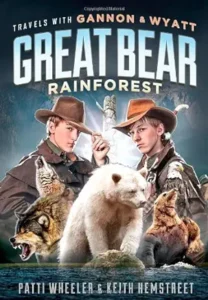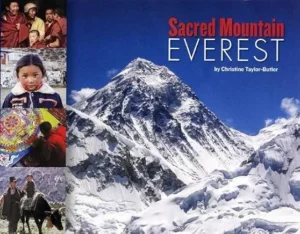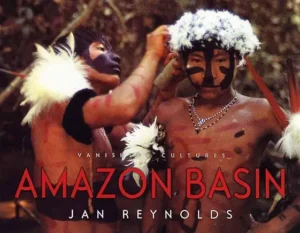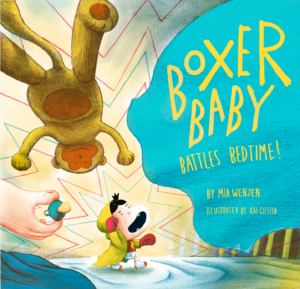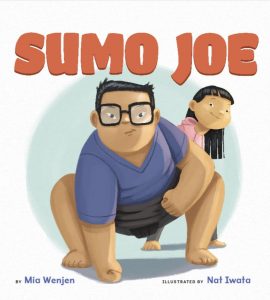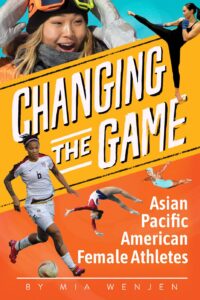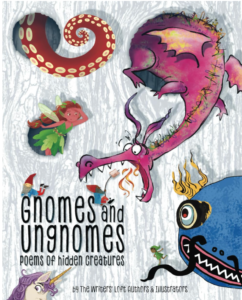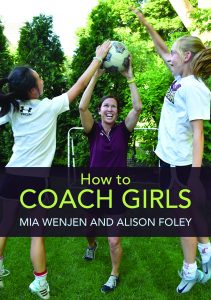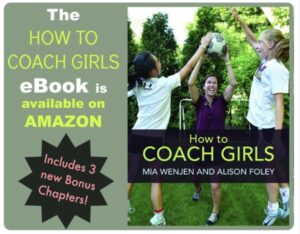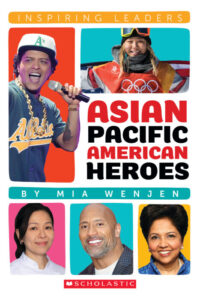This year’s Read Your World’s Classroom Kit is on Climate Change and Environment Justice. But what exactly does that mean? I am using this book list to explore this topic with 44 Children’s Books on Climate Change and Environmental Justice. Are they the same or different?
What Is Climate Change and Global Warming?
Climate Action: What Happened and What We Can Do by Seymour Simon
Whether you call what’s happening global warming or climate change, it’s still the biggest challenge humanity has ever faced. Global warming causes climate change, so the two terms are easy to confuse.
It’s up to us to turn everything around, and this book describes in clear and understandable terms what’s at stake. Extreme weather such as heat waves, and mega-droughts contribute to wildfires, deforestation, ocean acidification, and wildlife destruction. The most important point is that kids CAN make a difference. They are not too young to understand science and this book helps illuminate what can be done and why.[nonfiction picture book, ages 6 and up]
Climate Action: The Future is in Our Hands by Georgina Stevens, illustrated by Katie Rewse
What does it mean to have a carbon footprint? What is climate change and how is it affecting our world? This book lays out the causes of climate change in a straightforward and easy-to-understand manner. It also shares hope with creative ideas for how to tackle the climate crisis. Young changemakers are spotlighted throughout the book, providing further inspiration that we can all take action and make a difference. [nonfiction picture book, ages 7 and up]
Our World Out of Balance: Understanding Climate Change and What We Can Do by Andrea Minoglio, illustrated by Laura Fanelli
Pair this book with Climate Action for a deep dive into understanding global warming. This book gets into the Why of how things happen, breaking down the component parts to make it easy to understand how humans can help. Focusing on what we all can do as individuals helps to balance the urgent message. [middle grade nonfiction, ages 8 and up]
What is Climate Change? by Gail Herman
For readers who like to learn science concepts through narrative nonfiction, this book takes the reader down the road to explain climate change, how it happened, and how it’s currently affecting our planet. Photographs and black and white illustrations help to break up the text. This is a succinct way to learn about climate change. [middle grade nonfiction, ages 8 and up]
Environmental Justice Heroes
The Forest Keeper: The True Story of Jadav Payeng by Rina Singh, illustrated by Ishita Jain
In 1979 when the river, overflowing from the monsoon season, washed away the trees on an island in northwest India near Jadav Payeng’s home, he decided to plant trees on the sandbar himself. It seemed like an impossible task. Jadav figured out a watering system to give himself more time to plant trees. He preserved for year after year, planting many species of trees that grew into a forest, attracting wildlife … birds, rhinos, deer, wild boar, tigers, and even elephants. Now known as the Forest Man of India, Jadav continues to plant trees and his forest has now grown to be larger than Central Park in NYC. It’s called Molai Forest. [picture book biography, ages 5 and up]
Stand As Tall as the Trees: How An Amazonian Community Protected the Rain Forest by Patricia Gualinga and Laura Resau, illustrated by Vanessa Jaramillo
Patricia “Paty” Gualinga is an international Indigenous Rights defender, and also the daughter of a long line of wise Kichwa yachak or shamans living in the rain forest of Ecuador. She left her village to study and was called back to defend her rainforest when men came to drill for oil, destroying the land. She works with other Indigenous peoples as well as with lawyers and environmental groups to work to stop the destruction. In 2012, three years after Paty first began her activism, the Kichwa people won! Paty’s inspiring true story is a brave example of how activism can keep the rainforest alive. [picture book biography, ages 6 and up]
Seeds of Change: Wangari’s Gift to the World by Jen Cullerton Johnson, illustrated by Sonia Lynn Sadler
Wangari’s mother introduced her to the mugumo tree, telling her that their people, the Kikuyu of Kenya, believe that their ancestors rest in the tree’s shade. The tree is also important as a fruit tree that many species including geckos, humans, and elephants enjoyed. Her parents sent her to school, unusual for a girl at that time and she excelled at academics, continuing her higher education studies in the United States. When she returned, she found that trees were being cut down in Kenya to make way for tea and coffee plantations, destroying the land through soil erosion. Wangari decided to plant trees and won the support of other women. Together, they started The Green Belt Movement, planting more than 30 million trees. Wangari did not let corrupt politicians or greedy business people intimidate her. She spread her message as the “Mother of Trees” and won a Nobel Peace Prize in 2004 for her work. [picture book biography, ages 6 and up]
The Leaf Detective: How Margaret Lowman Uncovered Secrets in the Rainforest by Heather Lang, illustrated by Jana Christy
Meg Lowman pursued her passion for science in college, eventually following it to the tropical rainforests of Australia. There she pioneered tree canopy research and discovered a new frontier filled with biodiversity. Meg made important discoveries and invented new ways to access the canopy, including the first canopy walkway. But when she realized trees were in trouble from deforestation, she changed gears and began working to come up with creative ways to save rainforests in countries like Cameroon, Western Samoa, and Ethiopia. [nonfiction picture book biography, ages 5 and up]
Swimming With Sharks: The Daring Discoveries of Eugenie Clark by Heather Lang, illustrated by Jordi Solano
Eugenie Clark became the first scientist to study sharks in their natural habitat, an amazing achievement given the discrimination she faced as a woman in a field dominated by men. Her research shed new light on sharks showing that they were intelligent creatures and not voracious killers, important findings since warmer water from global warming is causing sharks to migrate to places they have never been seen before. [picture book biography, ages 5 and up]
The Life of Chico / La vida de Chico by Patty Rodriguez and Ariana Stein, illustrated by Citlali Reyes
This board book succinctly but comprehensively covers the life of Amazon rainforest activist Chico Mendes. While it doesn’t tell the reader that he was murdered, it does allude to his bravery in standing up to protect the land and the indigenous people living there. The friendly illustrations convey the story in an age-appropriate way. It’s never too young to expose toddlers to inspirational figures and this board book does a great job of getting readers to understand the inequities he faced and how he stood up and made a difference. [bilingual Spanish board book, ages 1 and up]
Forest Fighter: The Story of Chico Mendes by Anita Ganeri, illustrated by Margaux Carpentier
The life of a rubber tree tapper is a hard one and not unlike sharecroppers in that they are denied education to be able to read and write, are paid wages that keep them in debt, and work the land owned by other people. When the rubber plantations were sold to ranchers, the lands were cleared, destroying the rainforest. Chico Mendes decided to do something to protect the rainforest and started the Xapuri Union to challenge the government’s plan for the Amazon. As the protesters grew in number, the ranchers grew more violent. After Chico had success convincing the newly elected government of Brazil to set aside part of the rainforest as a reserve, he was murdered. Today, more than 10,000 people live in the Chico Mendes Extractive Reserve, but the Amazon rainforest continues to be destroyed at a rate of two soccer fields every minute! [picture book biography, ages 7 and up]
Heroes of the Environment: True Stories of People Who Are Helping to Protect Our Planet by Harriet Rohmer, illustrated by Julie McLaughlin
I have several anthologies of climate activists on this list and each is organized around a different theme. This particular one has the broadest range of people, both in terms of age and diversity. What I love about Heroes of the Environment is that it showcases ordinary people — some with a particular skill set perhaps — who just decided that they were going to do something about helping the planet, and then they just went out and did it. It really emphasizes the message that one person can truly make a difference. Most of the profiles are people whose names are not well known, and their contributions are based on what they can accomplish in their own community but their impact is inspiring and meaningful. A teenager and his friends recycle electronics to prevent toxic metals from getting into the environment. A Lucha Libra wrestler uses his fame to inspire kids to fight pollution. A teenage girl figured out how to test for a harmful chemical in her local river AND a way to remove it. Learn about 12 people who seem like ordinary people but are using their bravery, STEM skills, imagination, and community to help the environment. [biography middle grade anthology, ages 9 and up]
No World Too Big: Young People Fighting Global Climate Change edited by Lindsay H. Metcalf, Keila V. Dawson, and Jeanette Bradley, illustrated by Jeanette Bradley

Fourteen poems by children’s book authors spotlight young climate activists who are standing up for the Earth by planting trees, protecting water in Canada, reducing the carbon footprint of school buses in Indonesia, inventing alternative sources of power, starting a sustainability club at school, and more! Suggestions to fight climate change inspired by the young activists are also highlighted in the sidebars. [picture book, ages 5 and up]
We Have a Dream: Meet 30 Indigenous People and People of Color Protecting Our Planet by Dr. Mya-Rose Craig, illustrated by Sabrena Khadija
These thirty young BIPOC environmental activists are inspiring role models in the fight against climate change. They come from all over the world and have different approaches to how they protect our planet including speaking up, organizing and attending strikes and protests, planting trees, building an app, advocating governing bodies, and using a creative outlet such as writing to spread a message. It gives me hope that our global youth are not waiting for adults to take action. Instead, they are making it happen. [middle grade biography, ages 8 and up]
Climate Change and How We Can Make A Difference
Count on Us: Climate Activists from One to a Billion by Gabi Snyder, illustrated by Sarah Walsh
How does a movement grow? Learn to count from one to ten and then in increments up to one billion in this eco-picture book that shows how young activists can start small and still grow a powerful movement for change. [picture book, ages 4 and up]
Food for the Future: Sustainable Farms Around the World by Mia Wenjen, illustrated by Robert Sae-Heng
Visit twelve eco-friendly farms around the world. From urban gardens to farms under the sea, discover the many different sustainable ways people have been growing food for centuries, and new innovations that are battling the effects of climate change on farming. [picture book, ages 4 and up]
Ganesha Goes Green by Lakshmi Thamizhmani, illustrated by Debasmita Dasgupta
The Ganesha Chaturthi festival is a celebration of the Hindu god, Ganesha, and a way to celebrate new beginnings. Prema notices that when people place the Ganesha statues in the river, it harms the fish and the people get sick. She wants to find another way to honor Ganesha using the clay at the bottom of the river. It doesn’t go very well at first. But Ganesha is also the god of removing obstacles. Soon, her clay sculptures look perfect. She needs help if she wants to replace all the other Ganesha statues being sold. Her friends join her once they realize her clay Ganesha statues will dissolve without harming the river. Ganesha would approve! [picture book, ages 5 and up]
Planet Power: Exploring the World’s Renewable Energy by
Did you know that we can get renewable energy from the wind, water, and sun? Learn about six different types of eco-friendly energy through this rhyming picture book. [picture book, ages 6 and up]
Zonia’s Rain Forest by Juana Martinez-Neal
Told from the perspective of an indigenous child of the rain forest, the reader gets a glimpse into the delightful life of living harmoniously with nature. Zonia greets her animal friends and sees her world from their perspective. As she leaves to return home, she sees something new — her beloved rainforest destroyed by loggers. The forest needs her help and she is up to the challenge. [picture book, ages 4 and up]
Galápagos Girl by Marsha Diane Arnold, illustrated by Angela Dominguez
Valentina Cruz grew up among the animals of the wild Galápagos Islands, sea lions, Sally-lightfoot crabs, and manta rays. But when the wildlife is in trouble, she vows to keep the unique animals that live there safe. [picture book, ages 4 and up]
 The Purple Shell / La concha de mar purpura by Maritza Martinez Mejia, illustrated by Valerie Mojica
The Purple Shell / La concha de mar purpura by Maritza Martinez Mejia, illustrated by Valerie Mojica
Star’s mother surprises her with a trip to the beach but she is too upset by the trash on the shore to play. Instead, she and her mother clean the beach and recycle the trash. Finally, she has time to play in the ocean where she finds a beautiful purple shell. It’s a reward for all her hard work. A discussion guide and coloring sheets in the end matter make this an interactive experience! [bilingual Spanish picture book, ages 1 and up]
The Last Tiger: A Story of Hope by Becky Davies, illustrated by Jennie Poh
Aasha the tiger lives in a beautiful forest that is starting to change. It’s getting hotter and wetter and the animals are starting to leave. Now Aasha is alone and food is hard to find. Aasha discovers that the forest is being cut down by bulldozers, and she finds an orangutan hiding. Together, they travel in search of a new home. The end matter has a discussion guide about why tigers are disappearing and what readers can do to help. [picture book, ages 3 and up]
Coco la cotorra puertorriqueña by Frances Díaz Evans, illustrated by Alejandra López
Coco, a parrot raised in captivity, is finally ready to be released into the Puerto Rican rainforest. But when Coco finds the other parrots, the parrot is treated with suspicion for speaking differently and not being allowed to join the flock. Coco returns home to the aviary to see advice from Carombola, the parrot who raised it. Carombola reminds Coco that it has a special voice and also a special skill of being able to communicate with parrots and humans. That skill is called being bilingual. When Coco overhears men planning to cut down the trees in the rainforest, it warns the wild parrots and then returns home to get help from the humans who raised it. Together, they are able to stop the trees from being destroyed. Finally, Coco is welcomed into the wild flock of parrots. Families raising bilingual or multilingual children will appreciate this encouraging message in this story about the endangered Puerto Rican parrot. The end matter encourages readers to learn more about the flora and fauna of Puerto Rico. The author’s note also gives background on the Puerto Rican Parrot Recovery Program in which the parrots raised in captivity actually developed a different dialect from wild parrots! Pair this book with Parrots Over Puerto Rico. [picture book available in both Spanish and English, ages 7 and up]
Parrots Over Puerto Rico by Susan L. Roth and Cindy Trumborne, illustrated with collages by Susan L. Roth
This is not just the story of the Puerto Rican parrots, an endangered species, but also the history of Puerto Rico. By 1937, there were only about two thousand Puerto Rican parrots left living in El Yunque, a tropical rainforest in the mountains. By 1954, only two hundred Puerto Rican parrots were left, and by 1967, only twenty-four! Their demise was closely linked to the history of the island.
The people of Puerto Rico decided to try to save their parrots and an aviary was opened in 1973 to try to breed them in captivity, using Hispaniolan parrots as parenting surrogates since the Puerto Rican parrots raised in captivity did not know how to raise the chicks. This program faced many challenges, but, in the end, the program was able to release parrots back into the wild. [picture book available in both Spanish and English, ages 7 and up]
It’s Up to Us: Building a Brighter Future for Nature, People & Planet. The Children’s Terra Carta by Christopher Lloyd, with illustrations from 33 artists from around the world
This illustrated chapter book is a roadmap to taking care of our planet. Part one describes nature, part two describes people, and part three describes our planet. The final section, part 4, is the children’s terra carta — a pledge for sustainability. [illustrated chapter book, ages 6 and up]
The Eagle Mother by Hetxw’ms Gyetxw (Brett D. Huson), illustrated by Natasha Donovan
Much like the eagles, the Gitxsan depend on the salmon. The world of the Gitxsan people does not exist without all the beings within their ecosystem, so the eagles will always be present.
The Gitxsan Nation lives in British Columbia, Canada. In the valleys of the River of Mist, an eagle family rears its young. This book shows the eagles’ life cycle and the important role they play in their ecosystem. From the cottonwood tree where the eagles make their nest, to the salmon bones they drop below, readers are shown the connection between humans, animals, and nature. [picture book, ages 9 and up]
Luz Makes a Splash by Claudia Davila
The Luz graphic novel series has an environmental message and a diverse cast of characters with a can-do attitude. Together, they tackle the water crisis stemming from drought and from a nearby factory that threatens Luz’s two favorite places: the local swimming pool and Friendship Park. [graphic novel, ages 6 and up]
Stella Diaz Never Gives Up by Angela Dominguez
It’s summer vacation and Stella sees the ocean for the first time on a family trip to visit relatives in Mexico. She decides to become a marine biologist when she learns that the ocean is trouble. Stella’s best friend Jenny is in dance camp and Stella doesn’t understand why dance would be more important than cleaning up the ocean. With the help of old and new friends, Stella comes up with a plan that both supports Jenny’s dance recital and raises money and awareness for her cause. This book gives many examples of how kids can make small changes that are good for the environment and how this can ripple to make a much larger impact. Pair this book with Zero Waste Kids. [chapter book, ages 6 and up]
Music for Tigers by Michelle Kadarusman
Louisa is shipped off for the summer to live in a remote camp in the Tasmanian rainforest for the summer with her odd uncle. She’d rather stay home to practice violin for her youth symphony audition. She makes a new friend, Colin, who is on the Autism spectrum, and helps her get settled. He’s an amazing cook but he is on the Autism spectrum and struggles with making friends. Together, they discover her great-grandmother’s secret — she established a sanctuary for the rare Tasmanian tiger on Convict Rock. But only her great-grandmother was able to earn the animal’s trust. Louisa discovers a connection to the tiger with her music, and with the help of her uncle and friends, they hope to lure the last remaining Tasmanian Tiger on Convict Rock deeper into the rainforest before the miners take over, but will their plan work? [middle grade, ages 8 and up]
Manatee’s Best Friend by Sylvia Liu
Becca Wong Walker is very introverted and her only friends are the manatee mom and baby that visit the dock in her backyard. When a video she takes of the manatees with a wild dolphin goes viral, it’s her chance to convince her town to save the manatees but will she find the courage to speak up? [middle grade, ages 8 and up]
Haven Jacobs Saves the Planet by Barbara Dee
12-year-old Haven Jacobs gets crippling anxiety thinking about climate change and why adults don’t seem to do anything about it. When her social studies teacher assigns the class a way to make a difference to the planet, she decides to focus on the local Belmont River that her science class studies every year. But this year, something is missing. Her older brother tells her about the frogs they studied, but she and her classmates can’t find any. Could Gamba, the new company factory where her father works, be responsible for this change? But how can she expose the company without jeopardizing her father’s job and her friendships? [middle grade, ages 9 and up]
Thirst by Varsha Bajaj
In the slums of Mumbai where 12-year-old Minni lives, no one has indoor plumbing. Water must be collected every day at public pumps, but some days, the lines take hours when the water barely flows. And, when the monsoons come late, the water runs out and people must buy water from the water tank truck. One night, Minni and her friends stumble on a secret. The water mafia is stealing water from the public pumps. Suddenly her world is upside down. Her brother has to flee to the countryside. Her mother is ill and must move away as well to convalesce. Even worse, Minni has to take over her mother’s job as a servant until her mother is able to resume it. At the luxurious home of her mother’s employer, water comes flowing out of the taps. Minni wants to pursue her education, and now she must juggle her examinations, her new job, and a new computer class. She dreams of a world where there is enough water for everyone, but she will need to decide if someone small and insignificant can take down someone who is rich and powerful.
It’s easy to take clean water for granted and, while this story might feel like a “Mad Max” dystopian novel, it’s realistic fiction set in modern-day Mumbai. Minni’s teacher tells Minni and her classmates that only 5% of Mumbai’s water allotment goes to their area, despite being nearly 40% of the population. Like all scarce commodities, water is unevenly distributed. [middle grade, ages 10 and up]
Paradise on Fire by Jewell Parker Rhodes
Ever since her parents died in a house fire, Addy has always had an escape plan. Maps are her friends but when she goes to a summer wilderness program for inner-city Black kids, her map skills can’t compute this new terrain. Leo, the camp creator, teaches her how to create topological maps. Addy makes new friends at camp and they all learn new outdoor skills including how to put out a fire. Climate change has decreased the rainfall, making the forest fire season longer and more deadly. When they are all on a camping trip, Addy’s worst fear comes true. A raging fire comes their way. Will Addy be able to use her map skills to lead them out of danger? [middle grade, ages 10 and up]
The Amazon (The Wildes series) by Roland Smith
Ring and Asia Wilde are staying in a camp near the Xingu River in the Amazon rainforest while their mother, Dr. Jane Wilde, a world-renowned conservation biologist, conducts research on the Golden Lion Tamarind, an endangered species. The kids set off to find their mother only to discover that she’s been kidnapped. With the help of a Kayapo guide, Raoni, and accompanied by their hapless tutor, the children discover the key to finding their mother might lie in the gold mines nearby. This is a fast-paced mystery that pulls the reader into the wonders of the Amazon rainforest and the threats this ecosystem faces. [middle grade, ages 8 and up]
Consider the Octopus by Nora Raleigh Baskin and Gae Polisner
Two twelve-year-olds meet by synchronicity. Jeremy “JB” Barnes accidentally invites Sidney Miller onboard a research ship that is cleaning up the Great Pacific Garbage Patch. JB thinks Sidney is an important scientist but soon discovers his mistake. Sidney wants to hide out on the ship to avoid sleepaway camp now that her best friend moved away. Together, they scheme to keep her onboard, but funding for the ship’s clean-up is in jeopardy. Can JB and his friends find a way to bring attention to the 620,000 square miles of trash in the ocean between California and Hawaii? And, even more importantly, can they find a way to clean it up? [middle grade, ages 10 and up]
Global: One Fragile World. An Epic Fight for Survival by Eoin Colfer and Andrew Donkin, illustrated by Giovanni Rigano
This is a page-turner telling the story of two children from opposite ends of the world, both in peril because of global warming. Sami and his grandfather fish for a living in the Indian Ocean where the rising waters destroy their home and the depletion of fish make their job difficult and dangerous. In a far different climate, Yuki lives in the Far North of Canada, where rising temperatures cause the ice to melt, forcing Yuki’s village to relocate far away. The loss of habitat for the polar bears is also wreaking havoc. Yuki wants to save the polar bears that wander into villages like hers looking for food. Sami and Yuki’s dilemmas are connected to climate change but they are about to learn how small the world truly is as each embarks on a dangerous mission in a desperate attempt to make things right. [middle grade graphic novel, ages 10 and up]
Wings in the Wild by Margarita Engle
Soleida escapes from Cuba after her artist parents are arrested for their art which is criminalized for protesting freedom of expression. She flees to Venezuela where her aunt Vivi lives, but that is also not a safe haven. She and her aunt take a perilous journey where they are separated during a dangerous flash flood. Soleida is now living in a refugee camp in Costa Rica, stuck and feeling hopeless. Dariel is a Cuban American boy also in Costa Rica but under very different circumstances. His parents are famous actors but their hideaway in the wild of Costa Rica where they hide from is burned down. Once they meet, their lives become intertwined in a multi-pronged effort to 1) reforest the mountain almond so that wild macaws can be released, 2) get Soleida’s parents released from jail, and 3) express themselves through their creative art.
Margarita Engle weaves a story about Cuba, immigration, and environmental justice that soars, lifting the human spirit into a “can do” attitude in this fight to save our earth. [tween novel in verse, ages 12 and up]
Zero Waste Kids: Hands-On Projects and Activities to Reduce, Reuse and Recycle by Rob Greenfield, illustrated by Alissa Imre Geis
If you read the books on this list, you may think that a) our planet is in trouble, b) everyone can make a difference, and c) together we can help turn things around. And all of the above is true! If you are fired up and ready to roll up your sleeves but need ideas, this is the perfect book with 35 hands-on projects and activities where it’s all spelled out, and easy to execute. There is something for every age as well, from making your playdough to planting a garden to sorting and upcycling garbage. [activity book, for ages 6 and up]
Ecosystems
I have a post on Rainforests here. Here are books on more ecosystems.
Everglades Forever: Restoring America’s Great Wetland by Trish Marx, photographs by Cindy Karp
The Everglades are a subtropical wilderness located in Florida and found nowhere else on Earth! The Everglades are wetlands that provide a home to endangered animals including the manatee, American crocodile, and the Florida panther, and is half the size it was one hundred years ago. Only one-tenth the number of birds remains compared to two hundred years ago. Four children visit the Everglades National Park. They learn about how pollution and disrupted water flow threaten the Everglades but these manmade causes can also be fixed by human intervention. [nonfiction picture book, ages 8 and up]
The Mangrove Tree: Planting Trees to Feed Families by Susan L. Roth, illustrated by Cindy Trumbore
In Hargigo, a village in the African country of Eritrea, there isn’t enough food, but everything would change, thanks to one special tree. Mangrove trees can grow in brackish or salty water, providing food for goats and sheep. The villagers learn from scientist, Dr. Gordon Sato, how to grow a forest of mangrove trees, thus creating a new ecosystem that turns their village into a self-sufficient one. The story is told in the main body riffing off This is the House That Jack Built, but the interesting details are in each page spread’s sidebars. The Afterward provides a photo album to show how the mangrove forest was achieved. Dr. Sato named this project, The Manzanar Project, in homage to his experiences growing corn in response to hunger in the desert at Manzanar while imprisoned during WWII for being of Japanese descent. [nonfiction picture book, ages 7 and up]
Great Bear Rainforest (Travels with Gannon & Wyatt) by Pattie Wheeler and Keith Hemstreet
I didn’t realize that North America is home to a temperate rainforest in Vancouver, British Columbia.
Twin brothers Gannon and Wyatt are invited to join an expedition to the Great Bear Rainforest along with renowned environmental scientist Dr. Hans Brezner.
Aided by a trail guide, 15-year-old Alu, the brothers find themselves caught in a nefarious plan to destroy the Great Bear Rainforest by killing the migrating salmon thus disrupting the food chain.
The boys must find a way to overcome dangerous gunmen, a pack of hungry wolves, and Grizzlies to rescue their missing parents and protect this pristine wilderness.
This book combines nonfiction facts about the Great Bear Rainforest with an environmental message in an action-packed adventure. Their story is told through journal entries by both Gannon and Wyatt who exist in real life! [middle grade, ages 9 and up]
Sacred Mountain: Everest by Christine Taylor-Butler
The Sherpa leads mountain climbers up Mount Everest, the tallest mountain above sea level, but the mountain’s ecosystem is fragile. Some of the wildlife on Mount Everest can only be found there, including the Himalayan red panda, the Himalayan black bear, and the Himalayan tahr. The Sherpa’s sacred mountain is suffering from deforestation, related to tourism. The higher temperatures are also affecting the glaciers on the top of the Himalayan mountains, causing them to melt and flood the rivers, lakes, and villages. Sagarmathan National Park was created to protect this fragile ecosystem and is also a UNESCO World Heritage Site. [nonfiction picture book, ages 9 and up]
Amazon Basin: Vanishing Culture by Jan Reynolds
The Yanomama people live in the Amazon tropical rainforest located in Venezuela. The Amazon rain forest, called “the lungs of our planet,” absorbs 25% of the earth’s carbon dioxide and creates 6% of the earth’s oxygen through the process of photosynthesis, helping to stop global warming. They once numbered over five million in size but diseases from the white man decimated their population. This is a photo journal of a young boy, Tuwenowa, showing how the Yanomama indigenous people live in harmony with their surroundings and with each other. [nonfiction picture book, ages 5 and up]
p.s. Read Your World Classroom Kits:
FREE Teacher Classroom Kit Mental Health Support for Stressful Times
Multicultural Children’s Book Day NEW Classroom Kit on Structural Racism!
FREE Downloadable Classroom Poverty Kit: Understanding Poverty in America
New MCBD Classroom Kit: Activists & Activism!
Physical and Developmental Challenge Books for Kids
Diverse Kidlit Booklist & Activity Kit for Homeschoolers and Distance Learners
FREE Classroom Empathy Kit: Immigration & Refugees
FREE Classroom Kindness Kit from Multicultural Children’s Book Day
To examine any book more closely at Indiebound or Amazon, please click on image of book.
As an Amazon Associate, I earn from qualifying purchases.
Here is our Read Your World Event: Unique Perspectives on Hispanic/Latinx Children’s Books in Raising Awareness about Climate Change
p.p.s. Climate Change related posts:
10 Picture Books on People Protecting the Planet
Environmental Nonfiction Picture Books That Call Kids to Action
Kirkus reviews Food for the Future: Sustainable Farms Around the World
Best Children’s Books To Teach Green
10 Picture Books About Women Scientists Who Became Activists
The Kids Will Save Us: Youth Activists Children’s Books!
Barbara Dee on Parenting in Haven Jacobs Saves the Planet
Pictures Books About the Power of Protests and Activism
To examine any book more closely at Indiebound or Amazon, please click on image of book.
As an Amazon and IndieBound Associate, I earn from qualifying purchases.
Follow PragmaticMom’s board Multicultural Books for Kids on Pinterest.
Follow PragmaticMom’s board STEAM on Pinterest.
My books:
Food for the Future: Sustainable Farms Around the World
- Junior Library Guild Gold selection
- Selected as one of 100 Outstanding Picture Books of 2023 by dPICTUS and featured at the Bologna Children’s Book Fair
- Starred review from School Library Journal
- Chicago Library’s Best of the Best
- Imagination Soup’s 35 Best Nonfiction Books of 2023 for Kids
Amazon / Barefoot Books / Signed or Inscribed by Me

